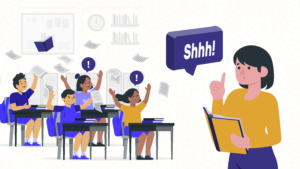
Since the dawn of human civilisation, groups of people have relied on a Guru/Teacher to pass on generational knowledge & skills that are required to navigate the real world. The same holds for the current era. However, as teaching-learning methods have evolved, the diversity of subjects has increased & “quality” teacher-to-student ratio has drastically fallen globally.
So, more than ever, there is a dire need for teachers to find ways to connect with students. The learners need to feel a sense of belonging, which in turn boosts student engagement & confidence. No matter how young or old you are, we all have at least one teacher from school who we still remember fondly, one who made us feel heard & alive.
To a few teachers, this trait may be natural. For others who find it hard to foster the connection, here are some unique approaches that may help
Eat the frog first:
There is always one or a group of students that are very mischievous & that are most often the ones who drive the overall energy of the class. Take control of that energy, and you’ll have won half the battle.
Have a rule of thumb:
A teacher’s temper is often the most off putting thing that drives students away. As a species, it is second nature to show dominance through anger. However, the display of rage may cause more harm to your relationship with the students in the long term.
The workaround for this is to have checkpoints – A rule of thumb. Stop yourself when you feel rage and ask a few questions:
- Is the issue worth being enraged about?
- Has this been continuing after repeated warnings?
- Have I tried to use dialogue to resolve this?
- Is there a way to communicate the problem without it feeling like a punishment to all?

Know their names:
The most underrated hack is to know your students’ names. It subconsciously makes them feel valued and creates a sense of belonging.
Spread optimism:
Everyone likes and looks up to optimistic individuals. Be that source of optimism for your students.
For instance a student would love to hear their teacher say “You are taking a unique approach to solve this Math problem, I’m eager to see the solution you’ll come up with” even when the student might be doing it wrong.
Quality over quantity:
Focus on delivering quality learning rather than ‘Completing portions’. Sticking to the timeline is essential, but not at the cost of compromised learning.
Say due to some unforeseen circumstances the required portions could not be competed in time. Rather than taking extra hours and cramming in all the chapters in one go, you could design an activity that can touch upon each of the left out topics & give them enough tools to self learn at home.

Take teaching outside the classroom:
Now and then, try to take teaching outside classrooms by gamifying concepts. For instance, a math class on numbers can happen on the sports field & a biology lecture on stomata can occur with a portable microscope in the garden. Outdoor learning increases sensory stimulation, in turn improving overall student engagement.
Be approachable:
Dedicate time to students who come to you for resolutions. Don’t limit these interactions only to academics. They may need help navigating mental stress, problems outside, or other concerns that society may deem ‘Silly’. This may be your chance to build a genuine connection & trust. Give them honest opinions to the best of your abilities, create a safe space & let them know that they aren’t alone.

Give actionable feedback:
What is often missing in the whole teaching-learning process is ‘Actionable’ feedback. Current feedback is very ambiguous, further increasing a student’s turmoil. Say a student has scored low on an English test; there can be two types of feedback:
- Announce the low marks in front of an audience & ask them to up the game.
- Check with them to understand the difficulty. If the difficulty is with vocabulary, then ask them to jot down one word a day with its meaning on a sticky note & paste it on the wall.

If you were a student, what would you have loved to hear?
Share the lunch table:
This is a game-changer! Listening to casual conversations during lunch can unveil valuable insights into the overall class dynamic. Understanding students’ perspectives outside the formal learning environment allows teachers to connect more deeply.
That said, while you try to form deep-rooted connections with your students, it is essential to set boundaries. It is paramount that you uphold the sanctity of the role you are playing.
A good education can change anyone, but a good teacher can change everything. With great power comes great responsibility – wield yours to transform the world through education.